|
Explanation: Up along
the west coast of Chile runs the cold oceanic Humboldt Current. During
periods of upwelling, the
current brings nutrients to the coast ecosystems, where reside a number of
wonderful species that take advantage of these times of productivity.
One species of which is the
relatively scarce Humboldt Penguin.
Here, colonies of Humboldt
Penguins are found on a series of near-shore "stacks" or rocky
islets along the coasts
of Chile and Peru.
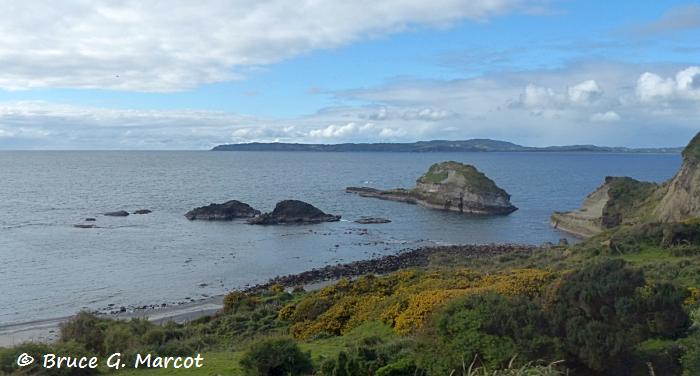
IUCN lists
the Humboldt Penguin as Vulnerable because populations fluctuate in
numbers nearly ten times in size between large and small cycles. There
has also been a loss of some breeding colonies signaling recent and rapid
declines, with current IUCN estimates of less than 45 thousand total birds
(approximately 12
thousand breeding pairs) across their range. They used to number in
the hundreds of thousands to over a million before many of their islands were
mined for bird guano used for fertilizer, devastating much of the penguin's
breeding-colony habitat.
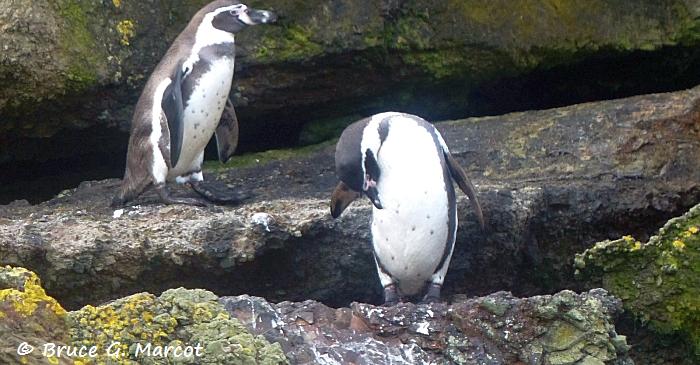
Humboldt Penguins have one dark bar across the chest,
unlike their cousin the Magellanic Penguin that
sports two chest bars and that
also occupies these off-shore islands.
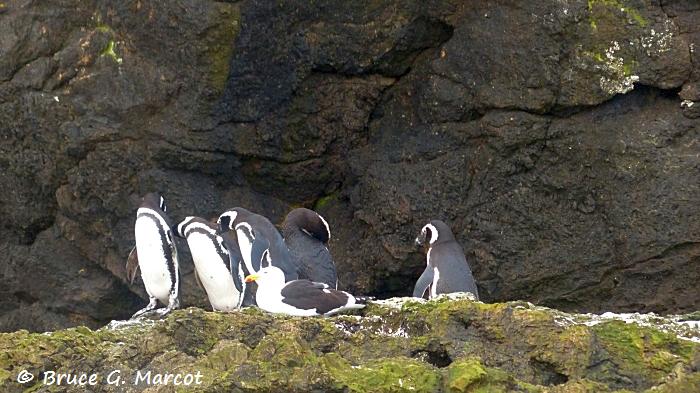
On the edge of the immense Pacific Ocean,
Humboldt Penguins often squeeze tightly into
available ledges and crevices on off-shore islands,
sometimes sharing the scant space with other species
(note the Kelp Gull nesting in the foreground).
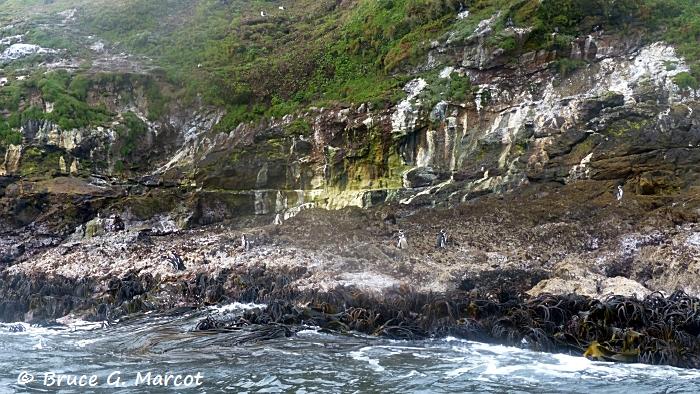
There be penguins here!
These small off-shore islets can be rather diverse places.
From the bottom of the above photo upward
are a series of layered ecosystems:
marine, kelp beds, rocky shelf,
then guano-stained cliffs with narrow ledges,
and higher is scrub vegetation.
Each stratum holds unique ecological
communities, resources, and ecosystems.
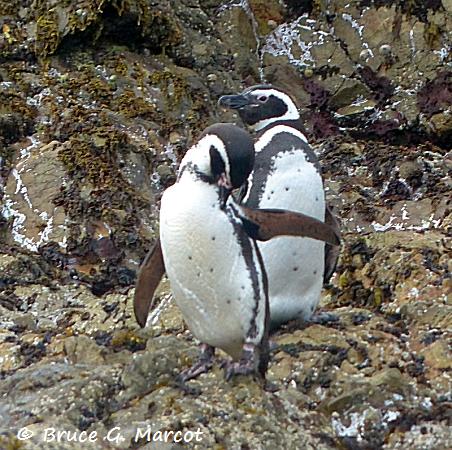
Here we see close cousins:
a Humboldt Penguin (Spheniscus humboldti) on the left
and a Magellanic Penguin (Spheniscus magellanicus) on the right,
sharing scant space for breeding and resting.
Both feed on fish in the sea,
so that food bounty must be sufficient
to permit coexistence on the rocky shoals. On
Chiloe Island of Chile, where we are, is one of the
few spots where the ranges of the two species overlap!
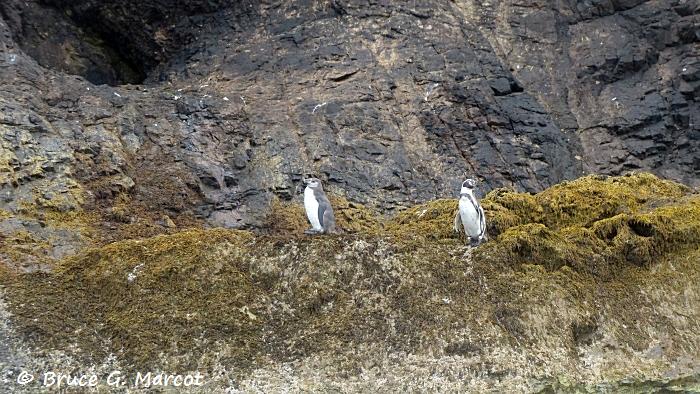
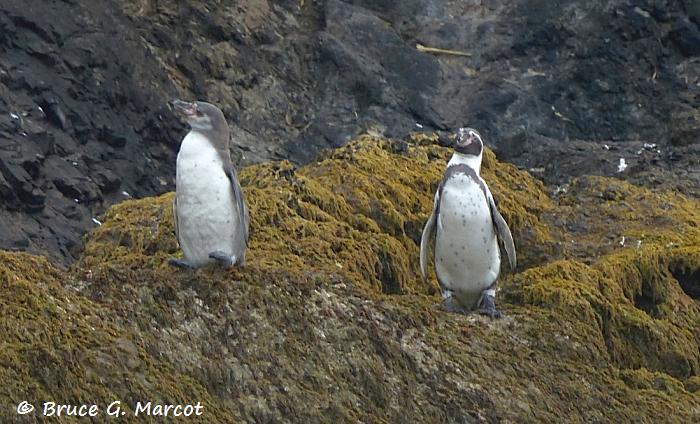
Adult (right) and chick (left) Humboldt
Penguin, chillin' in Chile.
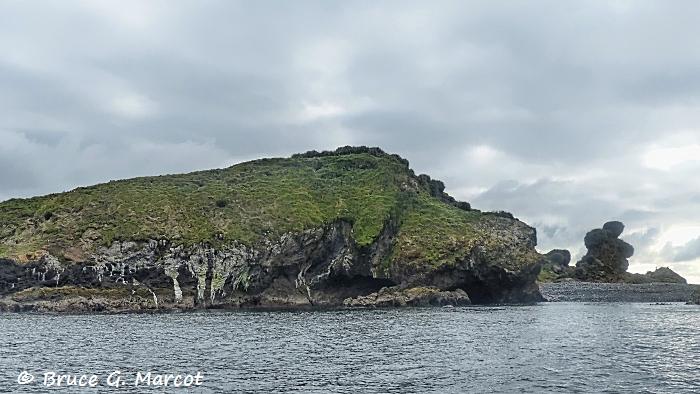
These penguin colonies require isolated,
pristine island environments, and
are very sensitive to human disturbance.
Our visit was carefully managed to stay
in the boat, off the islands, and at a respectful distance.
Humboldt
Penguins also can experience great stress during the El Nino periods when
their main prey species such as the anchovy Engraulis ringens becomes
scarce. During such times, there may be high mortality levels among the
penguins. To a certain
extent, Humboldt Penguins here in central Chile have adapted to some
uncertainty in the conditions of changing currents and food resources, by
developing two peak breeding seasons, one between August and January, and
another between April and June. And,
finally, hooray for Chile, for taking recent, bold steps, first in
August 2017 to reject
a proposed billion-dollar iron mine that would have seriously disturbed
habitat for the penguins and other species ... and then in March 2018 for establishing
a new law to protect its entire coastline and establish 9 marine reserves,
in part for conservation of the penguins.
Information:
Ellenberg, U., T. Mattern, P.J. Seddon, and
G.L.Jorquera. 2006. Physiological and reproductive
consequences of human disturbance in Humboldt penguins: The need for
species-specific visitor management. Biological Conservation
133(1):96-106.
Hays, C. 1986. Effects of the
1982-1983 El Nino on Humboldt penguin colonies in Peru. Biological
Conservation 36(2):169-180.
Simeone, A., B. Araya, M. Bernal, E.N. Diebold,
K. Grzybowski, M. Michaels, J.A. Teare, R.S. Wallace, and M.J.
Willis. 2002. Oceanographic and climatic factors influencing
breeding and colony attendance patterns of Humboldt penguins Spheniscus
humboldti in central Chile. Marine Ecology Progress Series
227:43-50.
|
Index |
Location | Search | About EPOW | ... Next >
Google Earth locations